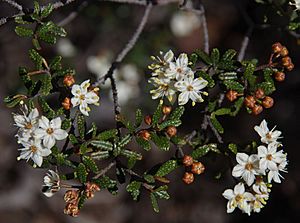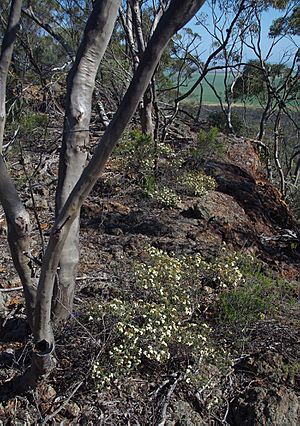Phebalium megaphyllum facts for kids
Phebalium megaphyllum is a special type of plant, a shrub, that grows only in Western Australia. It's known for its bumpy branches, unique leaves with a groove, and pretty white flowers that grow in small clusters.
Quick facts for kids Phebalium megaphyllum |
|
|---|---|
 |
|
| In Wongan Hills | |
| Scientific classification | |
| Genus: |
Phebalium
|
| Species: |
megaphyllum
|
Contents
What Does Phebalium megaphyllum Look Like?
This plant is a shrub that stands upright and has a rounded shape. It usually grows to be about 0.4 to 2 meters (which is about 1.3 to 6.5 feet) tall. Its small branches have tiny bumps on them, like warts, which are actually little glands.
Leaves and Stems
The leaves of Phebalium megaphyllum are shaped like a long rectangle or a wedge. They are about 7 to 15 millimeters (0.3 to 0.6 inches) long and 2 to 4 millimeters (0.08 to 0.16 inches) wide. Each leaf sits on a short stalk called a petiole. The top of the leaf is smooth and has a groove down the middle. The underside of the leaf is covered with shiny, silver-colored scales and has a bumpy vein running through it.
Flowers and When They Bloom
The flowers of this plant are white and grow in small groups called umbels. Each umbel has three to six flowers, and they appear at the ends of the branches. Each flower has a small stalk, about 4 to 6 millimeters (0.16 to 0.24 inches) long.
The flowers have five sepals, which are like small leaves that protect the bud. These sepals are about 3.5 to 4.5 millimeters (0.14 to 0.18 inches) long and are joined together for about half their length. The outside of the sepals is covered with reddish-brown scales. The petals are broadly oval-shaped, about 4 to 5 millimeters (0.16 to 0.2 inches) long and 2.5 to 3.5 millimeters (0.1 to 0.14 inches) wide. They are covered with either silver or reddish-brown scales. This plant blooms from September to November.
How Was Phebalium megaphyllum Named?
This plant was first officially described in 1907 by a scientist named Alfred James Ewart. He gave it the name Eriostemon tuberculosus var. megaphyllus. He published his description in a scientific paper called Proceedings of the Royal Society of Victoria.
Later, in 1998, another scientist named Paul G. Wilson changed its name to Phebalium megaphyllum. He published this change in a science journal called Nuytsia.
Where Does Phebalium megaphyllum Grow?
Phebalium megaphyllum grows in the dry, scrubby areas of Western Australia. You can find it on rolling plains, on hills made of ironstone rock, and near steep cliffs called breakaways. It grows in an area stretching between the towns of Mullewa, Coolgardie, and Ravensthorpe.
Is Phebalium megaphyllum Endangered?
The good news is that the Government of Western Australia's Department of Parks and Wildlife has classified Phebalium megaphyllum as "not threatened." This means it's not currently at risk of disappearing.


